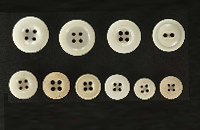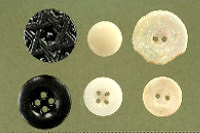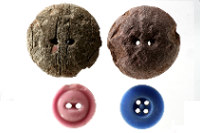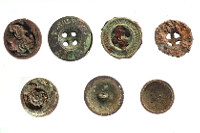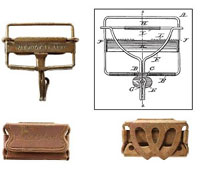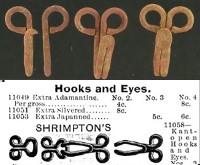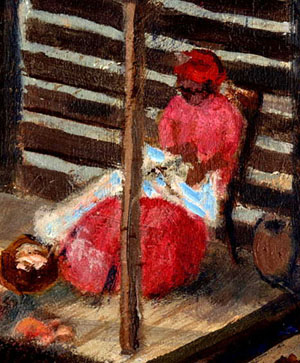
Sarah Williams is taking a break from the more rigorous chores of a farm wife to attend to her sewing. She loved working on the quilt that she was piecing together using colorful blocks of calico. But there was always a pile of worn overalls that needed mending or patching, and shirts and dresses that needed new buttons.
Most women in the 1800’s learned to sew and mend when they were still small girls. No doubt Sarah is making sure that her daughters are well prepared to make and mend clothing for their future families.
Although the first sewing machine was invented by Thomas Saint, an English man, in 1790, much of the routine sewing and mending was done by hand throughout the 1800’s. “Taking in” sewing, that is sewing and mending clothing for other families, was also an acceptable way for women to make extra money. Perhaps Sarah Williams added to the family’s income this way.
See what the archeologists found!
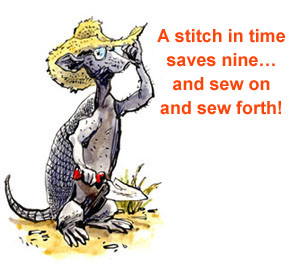
Sarah William’s sewing kit would have included scissors, thimbles, needles, pins, buttons, and hooks. Archeologists found all of these items at the Williams farmstead. In fact, there were so many artifacts related to sewing and clothing that we think Sarah, and possibly her daughters as well, may have been sewing for neighbors in addition to taking care of the needs of their own family.
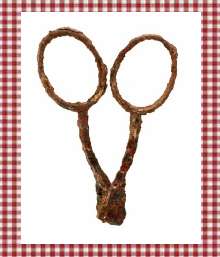
The archeologists found a pair of rusty scissors handles (missing their blades). They were just the right size for cutting fabric. Sarah likely used these to cut out patterns for new shirts and dresses and to cut the squares for her quilts.
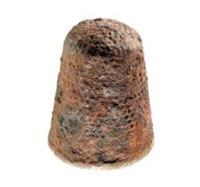
The thimble shown below probably protected Sarah's and the girls' thumbs from being jabbed by their needles while sewing. Did you know thimbles date back almost 1800 years to ancient China? In medieval Europe, thimbles were made from thick leather, bone, and ivory as well as brass. In the 1700’s, silver thimbles were a popular gift for ladies in America. While thimbles may be very plain or covered with small geometric designs, they can also be very elaborate with engraved pictures and initials. Sarah’s thimble is very rusty, having been buried in the ground for so many years, but it appears to be simple in design.
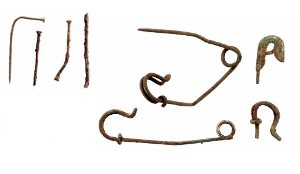
Both straight pins and safety pins were found at the farm. Straight pins were used to pin clothes while sewing. Safety pins were used for fastening diapers and other clothing. The modern safety pin was patented by an American mechanic named Walter Hunt in 1849. Hunt used an 8-inch piece of brass wire and designed a coil in the center so the pin would “spring” open. There is a clasp at one end to shield the wearer from the sharp point.
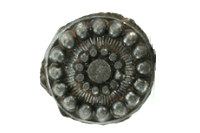
Velcro and zippers, so popular in clothing today, are inventions of the 20th century and make our lives easier. In the 1800’s, clothing was fastened with ties or laces, small metal hooks, and most frequently, with buttons. Sewing these tiny items onto clothing was time consuming for the seamstress.
Just look at all these buttons! Nearly 450 buttons were uncovered during the excavation of the Williams’ farmstead. They came in a wide variety of styles, sizes and materials. Some were cut from bone or shell. Others were made of metal, glass or hard rubber. Some are small, about 3/8 inch in diameter, and rather plain in design; these were commonly used on men’s shirts. A few of the buttons are of bright colors or have engraved designs, such as sunbursts, flowers, and swirls. These fancier buttons probably added a stylish touch to clothing worn to church or for special occasions.
On the left you can see a U.S. Army uniform button. It is made of brass and has an eagle design on the face and a maker’s stamp that says “SCOVILLS & Co. EXTRA on the back.
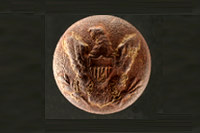
Hook and eye enclosures, measuring less that a half inch, were often used on the neckline and the cuffs of dresses. They could also be sewn one after the other in a very closely spaced line down the back of a dress to join the fabric like a step-by-step version of a zipper. Catalogues from the 1890s advertise hooks and eyes, 2 dozen to a card, in black and silver. Click on the photo on the right to see how much they cost.
On the left you can see a U.S. Army uniform button. It is made of brass and has an eagle design on the face and a maker’s stamp that says “SCOVILLS & Co. EXTRA on the back.
In the nineteenth century, men's trousers were commonly held up with a pair of suspenders rather than a belt running through belt loops. Suspender straps usually had buckles on the end, and these could be adjusted to regulate the length of the strap. The buckle at top left is stamped with the patent date of 1890, and matches the patent drawing showing the mechanism of the buckle. Many times archeologists consult historical catalogues and patent documents to help identify the artifacts they find.
With as many 9 to 11 people living at the Williams farm at any given time, sewing was a very important activity! Lost buttons and torn clothing required repairs, and Sarah and the girls probably made some clothes from new or recycled fabric, especially for the young children. They may have also made and repaired bed sheets, pillow cases, quilts, and window curtains.

